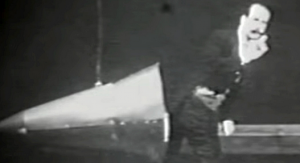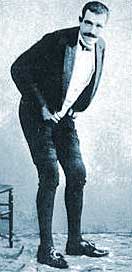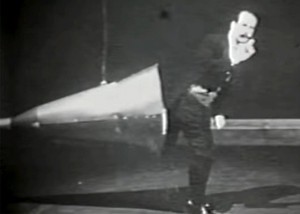Once upon a time in the south of France, a teenager named Joseph Pujol was playing in the surf at the beach. As he bent over and prepared to dive beneath the waves, he took a huge breath—and felt an icicle of cold stabbing him from the inside. With growing horror, he realized he’d somehow “inhaled” a buttful of water.
The water gushed out of his rectum a moment later, and he felt fine. Still, he ran to the family doctor, who chuckled and told him to forget about it. But the boy couldn’t. He refused to go swimming anymore, and he never breathed a word of the incident until his early 20s, when he entered the French army. There, in one of those crude gross-out sessions that seem to break out whenever young men gather, Pujol described what had happened to him that day on the beach. His comrades thought the story hilarious and dared him to try again. Curiosity overcoming fear, he tromped down to the beach on his next furlough and found that he could give himself a cold salty enema at will.
All of this would have been little more than an odd anecdote, except that one fateful day—no one knows how—Pujol discovered that he could pull the same trick with air. He first bent over double, which made it hard to breathe. He then plugged his nose and mouth and contracted his diaphragm, which expanded the volume of his abdomen. Volume and pressure are intimately related with gases: As one rises, the other falls. So expanding his abdomen necessarily lowered the pressure inside it, creating a partial vacuum. Normally when the diaphragm does this, air rushes in and fills our lungs. But because Pujol had bent over and plugged his mouth, air rushed in through the out door instead. Best of all, after inhaling the air, Pujol ripped loose the most epic fart of his life. He was thrilled—and ran off to show his fellow soldiers.
Pujol spent the next several years perfecting this “skill,” until he could fart without interruption for 10 to 15 seconds. He found he could vary the pitch and volume of farts as well, playing them like musical notes. He’d always been a theatrical boy, constantly singing and dancing, and after he honed his repertoire in the barracks, he grew a mustache and hit the road with his act in the mid-1880s. He dubbed himself Le Pétomane—the Fartomaniac.
He finally worked up the courage to audition for the famous Moulin Rouge nightclub in Paris in 1892. The job interview consisted of him dropping his trousers, cleansing his “instrument” by sucking up water (he normally gave himself five enemas per day), then serenading the owner. The owner, flabbergasted, hired him immediately.
Audiences didn’t know what to make of Le Pétomane at first, but within two years he’d become the highest-paid performer in France, earning 20,000 francs for some shows, more than double what the legendary actress Sarah Bernhardt did. When the curtain opened, he appeared onstage in a black satin tuxedo with white gloves and a red cape. (He wore the tuxedo partly for the incongruity and partly to hide the strain of forcing himself to fart over and over.) After the first laughs died down, he’d do impressions. A short, high toot for a little lass. A meaty blat for a mother-in-law. A bride on her wedding night (a shy peep), and then a few months into the marriage (a thunderclap). He imitated roosters, owls, ducks, bees, toads, pigs, and a dog whose tail got caught in a door. He brought the house down when he played a flute backward. Near the end (ahem), he stepped offstage and re-emerged with a tube inserted into his anus, like a tail. The other end had a lit cigarette wedged into it, and he proceeded to blow smoke rings out of both ends at once. For the finale, he gave a rousing rendition of “La Marseillaise,” then puffed out a candle from several feet.
Women in the audience, especially those wearing corsets, often laughed so hard they passed out. One man had a heart attack. (The Moulin Rouge took advantage of this by stationing nurses around the theater and by posting warnings about how dangerous the show was— which of course only made people more eager to attend.) And lest you feel guilty for giggling over toilet humor here—or are too stuffy to see what’s so funny—know that Le Pétomane hobnobbed with Renoir and Matisse, and that Ravel adored him. Legend has it that Freud kept a picture of Le Pétomane on his wall and drew on him when developing his theory of anal fixation. Even the king of Belgium came to see the “fartiste” once, albeit incognito.
So what was going on back there with Le Pétomane? To start with, let’s examine what farts are. Partly air. Every time you swallow food or water you ingest a few milliliters of air. Most of this gets burped back up. But some fraction, especially if you’re lying down, seeps into the stomach and intestines, where it starts to migrate south.
Some 75 percent of every fart is produced “in house” by bacteria in the gut, through a process called fermentation. We lay folk normally associate fermentation with beer, but there’s actually a lot more to it: Fermentation covers a wide variety of cases in which carbohydrates get digested and broken down into smaller metabolites. In this case, fart-fermenting bacteria swallow and break down chains of carbohydrates into carbon dioxide, hydrogen, and methane; the microbes then belch them back up, filling our guts with gas. We call certain foods gassy because they contain carbs (the lactose in milk, for example, and the raffinose in cabbage and broccoli) that don’t break down much in the stomach and therefore provide a feast for these microbes in our intestines.
The average adult farts around three pints of gas each day, in roughly 20 parcels. Those numbers can vary widely, though. Le Pétomane inhaled almost six pints with each butt breath, and one man in the medical literature cut the cheese 10 dozen times each day. Such vast quantities of gas can rupture the intestines if they get trapped and can’t find an outlet. In one gruesome case, surgeons cauterizing a man’s colon ended up igniting a pocket of gas, blowing a six-inch hole in his abdomen.
Surprisingly, more than 99 percent of the gas in farts has no smell. Even methane, despite its bad reputation, has no odor. Rather, most of the pungency of gas comes from a few trace components: hydrogen sulfide (H2S), which reeks of rotten eggs; methanethiol (CH3 SH), which stinks of rotting vegetables; and dimethyl sulfide (CH3 SCH3), which smells cloyingly, sickeningly sweet. They’re collectively known as volatile sulfur compounds, and they emerge, once again, from the oversated bellies of bacteria. These same gases also contribute to the stink of morning breath. (Try not to think too hard about that.)
So that’s how farts work. But it might surprise you to learn that none of that has anything to do with Le Pétomane. Remember, he wasn’t scarfing broccoli or chugging raw milk to fill his guts with gas. He was just inhaling good old everyday air and pushing it right back out. As a result, the Fartomaniac’s farts, at least onstage, didn’t smell. In fact, he eschewed scatological humor in his shows, thinking it vulgar. Rather, he considered himself something between a singer and an impressions guy, like a vaudeville Man of a Thousand Voices.
Which brings up a serious, if startling, question. Both ends of the body have tubes that allow air to pass through. So why don’t we “speak” through our rear ends? There’s no a priori reason why not. The anus lacks vocal cords, of course, but those are nothing special, just flaps to help keep food and water out of our airways; the anal sphincter can buzz like a trumpeter’s mouth anyway, which is almost as good. A bigger problem is that our butts lack lips and tongues (thank goodness), the organs that mold emerging air currents into words. But really, we could get by with far less complicated oral equipment for basic communication. Overall, then, evolution easily could have done a U-turn long ago and developed fancier folds around our anuses for rectal talking. A few species of herring reportedly do communicate by farting.
After a few glorious years at the Moulin Rouge, Le Pétomane got into some legal skirmishes with the owner. First he got caught crooning at a gingerbread stall in the marketplace, trying to attract business for a friend. After this the owner sued him for breach of contract, arguing that Le Pétomane was allowed to fart only inside the club. (Newspapers found this uproarious.) The Fartiste eventually quit and founded his own club, which prompted more legal wrangling, especially when the Moulin Rouge owner found a female fartomaniac to replace him. (Turns out she was a fraud: She had a bellows secreted beneath her petticoat. Le Pétomane had actually stripped naked before several doctors and undergone an examination early in his career when people accused him of the same thing.)
Although no longer the highest-paid act in France, Le Pétomane made a comfortable living at his new club for two decades, until 1914 turned Europe upside down. No one had time for such frivolity anymore, not even within Le Pétomane’s family: Two of his sons were maimed on the front lines. After the notorious chemical warfare attacks of World War I, gas-based comedy seemed in rather poor taste anyway.
After the war, Le Pétomane settled down and opened a bakery; he apparently made the best bran muffins around. When he finally died, a month after V-E Day in 1945, several doctors asked the family whether they could examine his plumbing to see what allowed him to inhale gases that way. Sadly, we’ll never know, since the family refused permission. As one of his sons explained, “There are some things in this life which simply must be treated with reverence.”
An excerpted from Caesar’s Last Breath, by Sam Kean. Copyright © 2017 by Sam Kean.
Sam Kean is the best-selling author of The Disappearing Spoon and The Violinist’s Thumb. His new book, Caesar’s Last Breath, about the secrets of the air, came out July 18.
Source: www.slate.com
Ask me anything
Explore related questions







